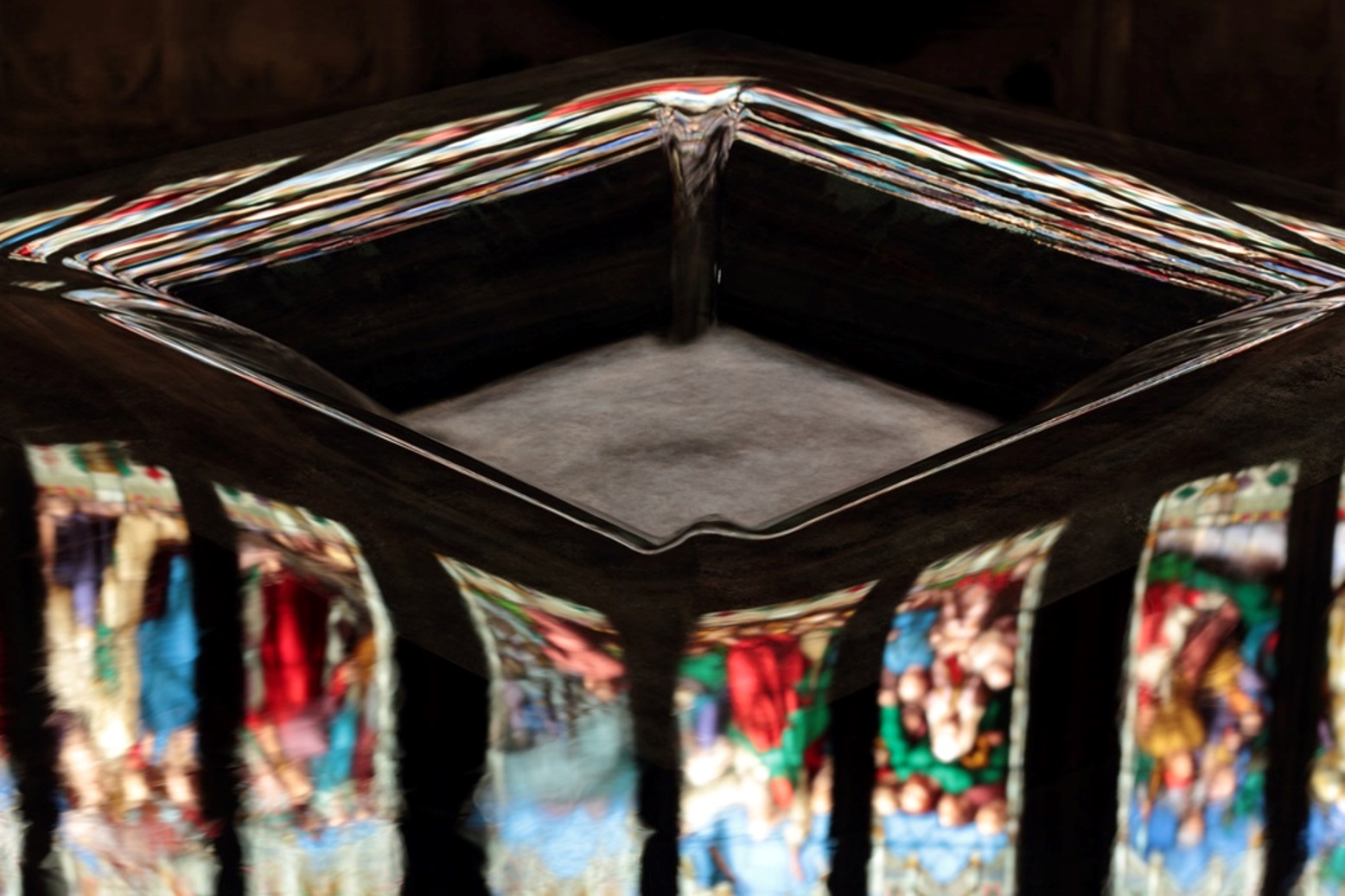Jake Flood: Reflection
Jake Flood: Reflection
Stillness and Turbulence
by Jonathan Evens
I was recently a judge for the Chaiya Art Awards, the UK’s largest awards exploring spirituality through the visual arts which for 2021 had the theme of ‘God is…’ From over 700 entries 50 visual artists featured in the winner’s exhibition explored the theme and encouraged us to look beyond, to discern what cannot be seen and grasp what cannot be described. Jake Flood’s Reflection is a profound expression of that encouragement.
Flood’s photograph is of Vesqua, a sculpture by British artist William Pye (b. 1938) which was among 70 contemporary sculptures installed in Gloucester Cathedral for Crucible 2 in 2014. Vesqua remained there until Easter 2015 when it was used as a font to baptise several people. Vesqua (2008) is from Pye’s series of Brimming Bowl water sculptures. Since the mid-seventies he has been inspired by the extraordinary qualities of water. A fascination with the natural laws of hydrostatics and how these can be manipulated has become an integral and crucial element of his sculptures, as with his font for Salisbury Cathedral.
Water is the predominant feature of Vesqua, its surface reflecting and extending the surrounding architecture. Surface tension maintains a flat disc of apparently still water at a level that is perceptibly higher than the rim of its bronze container. A significant flow of water enters the vessel and as this rises turbulence disappears to give an effect of stillness, despite the fact that some 135 litres of water per minute are slipping down the throat of a square internal weir that draws water down to a reservoir below. In this way, two contrasting aspects of water are woven seamlessly together: stillness expressed in the reflecting surface, and the flow and movement through the square edged weir.
Flood has said that: ‘The reflections edging the font mirror the ancient stories expressed in the surrounding stained glass. The centre is empty, offering a space to reflect and connect with God. I don’t believe in any deity, but working with survivors of slavery, moments of reflection, silence and stillness have expanded to enable community, cooperation and the beginnings of new stories – maybe that is God.’
Flood’s image sets the square edged weir at the centre creating a space that is empty and dark. The apophatic tradition in Christianity maintains that the place of emptiness – both personally and through the renunciation of images – is the place of encounter with God. As several Psalms suggest darkness can be a covering for God and, also, our closest friend.
Fringing the central space are reflections of the Cathedral’s stained glass which lie beyond the sculpture, but which the water’s stillness enables us to glimpse. Although the centre of the image is empty and monochrome, Flood’s image shares with us the surrounding diversity of colour. We cannot fully see the stained glass or read its story but can see sufficient to appreciate its richness.
Stillness and turbulence are core to Pye’s sculpture and feature, too, in Flood’s reflection. Turbulence, in working with survivors of slavery. Stillness, in moments of reflection during art therapy that enable connection.
Flood has created an image that is both apophatic and cataphatic, negative and positive, which reveals that God is absence and presence, stillness and disturbance, central and beyond. In these ways Flood’s image encourages us to look beyond, to discern what cannot be seen and grasp what cannot be described.
*******
Jake Flood: Reflection, 2021, photograph, 30 x 45 cm (h x w). Image ©The Artist.
Jake Flood is a British photographer and counsellor at Jake Flood Counselling, an Unseen ambassador and former manager of Unseen’s Men’s Safehouse, where he has led mindful photography sessions. Making photographs has enabled many survivors to begin to build confidence, heal wounds and find peace after their exploitation. He has more than 30 years of experience working in mental health, is a registered member of the BACP (British Association for Counselling and Psychotherapy) and has spent the last five years working with male victims of modern slavery and human trafficking. https://jakefloodcounselling.co.uk/
Unseen has its roots in Christianity, but this competition is open to people of all faiths, to those who have no belief in God, and to everyone in between. It’s about continuing an age-old conversation in a modern setting with contemporary eyes. It’s about asking big questions and looking for inspiration from the wealth of the UK’s creatives. These awards partner with Unseen to work toward ending human trafficking and modern slavery. The 2021 exhibition is showcasing some of the most innovative and exciting artists expressing their creativity in response to the theme ‘GOD is…’ View the exhibition online at https://chaiyaartawards.co.uk/godis.
Jonathan Evens is Associate Vicar for HeartEdge at St Martin-in-the-Fields, London, UK. Through HeartEdge, a network of churches, he encourages congregations to engage with culture, compassion and commerce. He is co-author of The Secret Chord, an impassioned study of the role of music in cultural life written through the prism of Christian belief. He writes regularly on the arts for a range of publications and blogs at https://joninbetween.blogspot.com.
ArtWay Visual Meditation June 27, 2021



